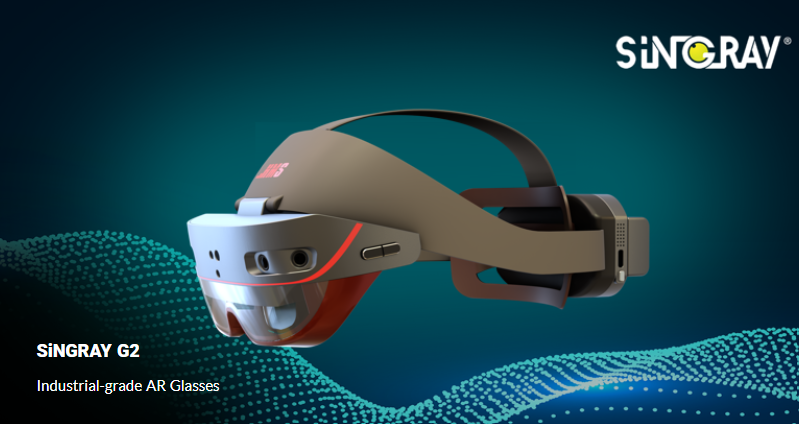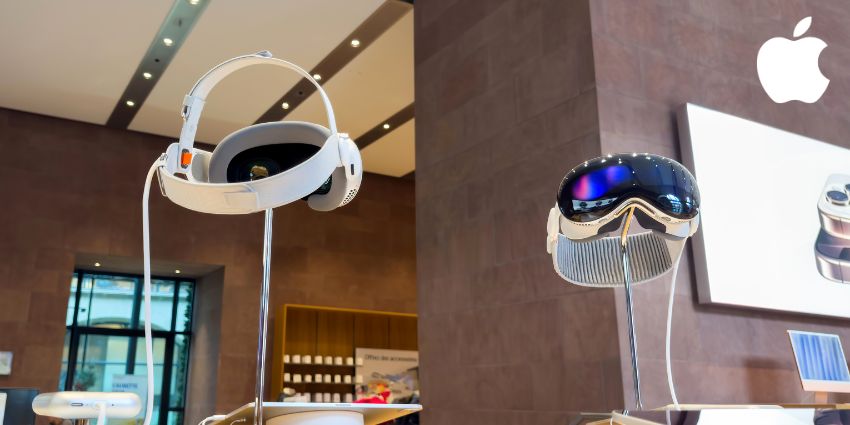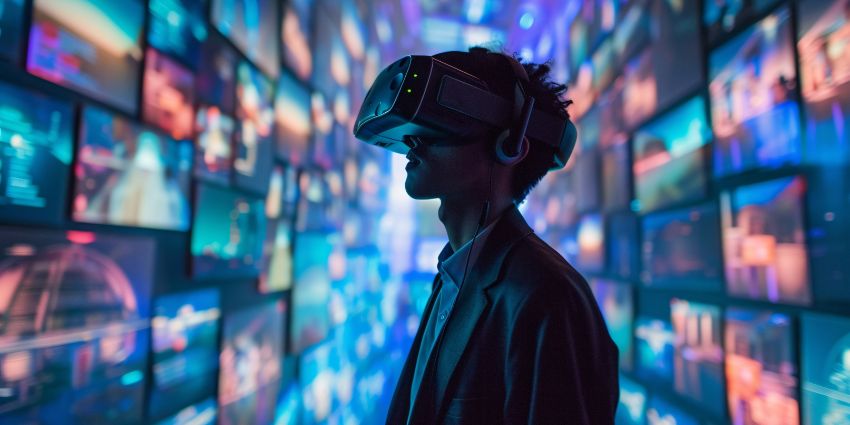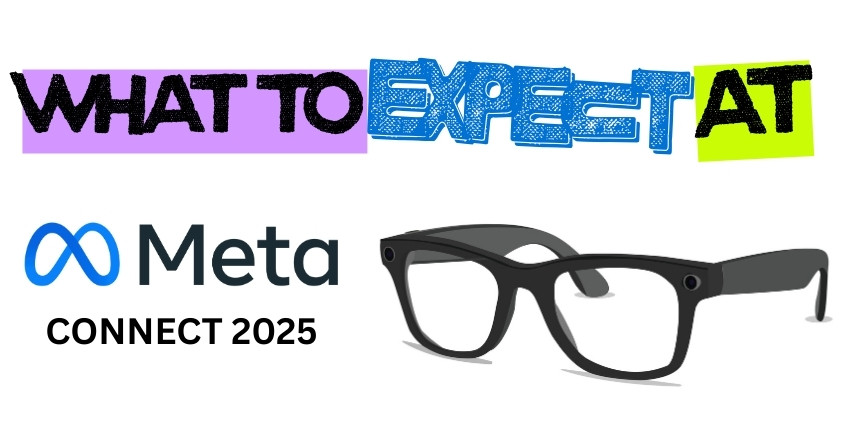Is the Samsung XR headset ever going to arrive? For some time now, technology fans and XR enthusiasts have been clamoring for updates. Samsung has been talking about an impending extended reality product ever since 2022’s Mobile World Conference.
Since then, the amount of concrete information actually revealed about this device has been extremely limited. In 2023, Samsung’s team was eager to draw attention to its new partnership with Google and Qualcomm, during their regular “Unpacked” event.
Plus, in early 2024, leaks revealed that the tech giant had developed its own separate “immersive team” specifically focused on designing an XR solution. Additional leaks throughout the year revealed some potential specs for the new headset. Additionally, Samsung itself confirmed that it definitely would be releasing a new solution at “some point” at Unpacked 2024.
While there’s plenty of evidence that Samsung does want to step into the XR landscape, ongoing rumors about delays and issues are beginning to cause concern for immersive technology fans. Here’s everything we know about Samsung’s XR journey so far.
Is a Samsung XR Headset Coming? Key Takeaways
Rumors and leaks are pretty commonplace when tech giants start discussing the potential arrival of new products. We saw plenty of them when Apple first began teasing the Apple Vision Pro, and when Meta began experimenting with the Meta Quest 3 (then the Quest 3S).
Unfortunately, rumors about a Samsung XR solution haven’t been particularly revealing. We don’t even know for certain what Samsung is planning on creating. It could be an XR platform, a mixed reality headset, or a set of augmented reality smart glasses.
All that Samsung has confirmed is that it’s working with Google and Qualcomm on something new. The rest of the information we’ve gathered, from rumors and leaks, really needs to be treated with caution. After all, even if the tech specs and documents shared by tech enthusiasts are legitimate, there’s no guarantee that what Samsung releases won’t be completely different.
Samsung’s TM Roh did say earlier this year that an XR device would hopefully be released at the end of 2024. However, elsewhere, reports suggest that the device has been delayed until 2025 – or potentially even 2026.
There could be numerous reasons for this. Samsung might be struggling to determine how it will give its device the best chance of success in the XR space. Originally, it seemed the company wanted to create an Apple Vision Pro competitor. However, since the Vision Pro hasn’t been nearly as successful as Apple had hoped, Samsung might have decided to switch lanes.
The company may even be considering a shift in to the augmented reality glasses market. Many competitors, including Meta, which showcased the Orion prototype at Connect 2024, seem to be betting big on this landscape so far.
Samsung XR: The Journey So Far
With so few “genuine” insights into an upcoming Samsung XR device available, we’re left to make “educated guesses” based on leaks and Samsung’s history in the industry.
After all, while Samsung hasn’t released an incredible XR headset or AR specs yet – that doesn’t mean it hasn’t dabbled in the market. Samsung was one of the first major tech companies to start experimenting with VR, with the launch of the Gear VR headset in 2015.
Sure, this headset was pretty simple compared to some of the XR headsets on the market today, like the Varjo XR-4 series, but it did show us Samsung was at least interested in XR.
After discontinuing the Gear VR headset, Samsung started working on the “Odyssey” headset for PC users. Unfortunately, this device still didn’t drive much commercial success for the company. However, it did earn some good reviews for its crisp visuals and comfortable design.
By 2018, Samsung had almost disappeared from the XR market, at least from a hardware perspective. However, it continued researching behind the scenes. In 2022, it shared its work on an AR-Haptic artificial muscle actuator and began working on digital twin technology.
Additionally, it’s worth noting that Samsung won’t be working on this new XR solution alone. It’s partnering with two of the biggest names in the industry: Qualcomm and Google. Qualcomm already powers most of the top smart glasses and VR headsets on the market today.
Google, on the other hand, might not have changed the world with its “Google Glass” specs, but the company has still accomplished a lot. It excels at creating operating systems for all kinds of devices, including AR apps and tools.
A Bumpy Road to XR Development
While an overall lack of information, alongside countless rumors about delays and issues have left some people to speculate that a Samsung XR headset will never arrive – we’ve still had a lot of positive news from the tech company this year.
At Unpacked 2024, Samsung did say that it wanted to release a headset this year. They might even be accelerating their production process to get ahead of the Apple Vision Pro’s international release.
But Samsung’s journey in the XR space has definitely been complicated. Initially, after Google, Samsung, and Qualcomm partnered in 2023, experts thought an XR headset would emerge by the end of the year. That didn’t happen – for a few reasons. The official release date was constantly moved back throughout the year, as Samsung faced construction and supply issues, and its partners focused their attention elsewhere.
Some insider analysts, like @OreXda, suggested the delays were primarily a result of the Apple Vision Pro headset being released. This MR headset placed serious pressure on Samsung to up its game. Promising better graphics and displays than Samsung could create.
Essentially, Samsung had to return to the drawing board, commissioning stronger, high-resolution screens to try and match (or at least compete) with Apple. Now, evidence is mounting that Samsung might need to change tactics once again, focusing less on creating an “Apple Vision Pro” competitor and more on creating something entirely new.
What Can we Expect from the Samsung XR Headset?
So, what can we expect if we believe Samsung’s claims that an XR device is coming? Again, nothing seems to be set in stone. For a while now, most analysts have assumed that Samsung will be creating a mixed reality headset, similar to the Meta Quest 3 or the Apple Vision Pro.
While there’s no guarantee that Samsung won’t create augmented reality glasses instead, the leaks and rumors we do have seem to support the “MR headset” theory. The leaked GeekBench listing, which emerged this year, for instance, doesn’t feature an image of the upcoming device.
Although, it’s worth noting that a few images were leaked throughout 2023 – although we’re not sure how accurate they were. The Geekbench listing, however, does list potential specs that are more aligned with an XR headset.
For instance, we know that Samsung’s device will likely feature 16GB of RAM, and a 6-core Android 14 chipset. It will also be powered by a new Qualcomm chip. That could potentially be something like the Snapdragon XR2+ Gen 2 chipset (unless a new solution is released soon).
Based on earlier leaks and rumors, Samsung will also use micro-OLED displays powered by Sony. These displays will offer a potential resolution of 3,840 x 3,552 pixels, a refresh rate of up to 90hz, and a brightness level of up to 1,000 nits. This could mean that the new Samsung XR headset (if it ever arrives) would offer slightly higher visual fidelity than the Meta Quest 3.
Exploring the Potential Chipset Specs
Although we don’t know anything about the Samsung XR headset’s appearance, battery life, or unique features, we do know it will use a Qualcomm chip. After all, Samsung specifically partnered with Qualcomm for this new device.
Qualcomm hasn’t leaked too many details about which chipset the headset will use. However, they have said it should be an upgraded version of the Snapdragon XR2+ Gen 2. This makes sense if Samsung wants to compete with Meta and the Quest 3.
Even if the “upgraded” chipset offers very similar functionality to the XR2+ Gen 2 as it stands today, it should deliver a fantastic user experience. Qualcomm has already said that the solution will be able to support two displays with a 4.3K resolution and a 90FPS refresh rate. It can also easily manage up to 12 concurrent camera inputs to track users, controllers, and objects in a space. This means it’s very likely that the Samsung XR headset will offer some mixed-reality features.
The chipset also has more advanced AI capabilities, and we expect AI will play a big role in any new device Samsung creates. After all, the company is working with Google – a brand that has already gone all-in on AI technologies in the last year, creating its own multimodal LLMs and generative AI assistants. Google even left customers questioning whether it might be creating its own set of new AR glasses following the Project Astra demo at Google I/O.
Beyond powering AI and mixed reality experiences, the Qualcomm Snapdragon chipset should also deliver stronger GPU performance and enhanced Wi-Fi connectivity (with Wi-Fi 7).
The Samsung XR Operating System
We know a little more about the potential operating system for the Samsung XR device. Since Samsung has been partnering with Google on this project since day one, it was obvious they’d be using an “Android” solution. This was confirmed by the leak on Geekbench, which listed an “Android 14” operating system in the specs.
Google’s team has also confirmed that the Samsung device should support an “open” platform for mixed reality, giving third parties more freedom to leverage the capabilities of the OS, Qualcomm chips, and Samsung’s technology. TM Roh said in 2023 that creating this platform would take a little more time but believed it was the “right” move for the team.
The approach does make sense, particularly since Samsung’s competitors are already taking a similar approach. Meta also made its Horizon OS ecosystem more accessible this year, encouraging third-party manufacturers to make headsets that could access the software.
Creating an “open” platform should ensure that if Samsung’s headset ever emerges, it doesn’t struggle with the same challenges as some of its competitors, giving users limited access to apps and games. One thing that can harm a product’s potential is lack of access to software, as Apple found out when the Vision Pro was first released.
How Much will the Samsung XR Headset Cost?
Now, we come to pricing – how much will Samsung’s headset cost? Based on the rumors; Samsung probably won’t be focusing on an extremely “budget-conscious” solution like the Meta Quest 3S. They seem to be investing in a lot of premium technology, which means there’s a good chance the headset will be even more expensive than the Quest 3.
However, we don’t think Samsung will want to make the same mistake as Apple, and create a prohibitively expensive product either. While there’s certainly room for higher-end headsets in the XR space, particularly for enterprise customers, they can struggle to deliver profits. This is something Apple has been struggling with constantly since the release of the Apple Vision Pro.
In fact, the stifled sales of the Vision Pro may be prompting Apple to focus on releasing a more affordable alternative before they consider working on something like a “Vision Pro 2.”
Early reports suggested that Samsung might be considering a price tag between $1,000, and $1,500. This would certainly make the headset less expensive than the Vision Pro (though more costly than the Quest 3). However, if Samsung continues to add more advanced features and components to its headset, that price could increase.
Hopefully, Samsung will find a way of balancing high-end features with a price that customers can afford. Otherwise, the company could set itself up for failure before it’s really had a chance to make an impact in the XR space.
The Samsung XR Headset Release Date
We’ve discussed “possible” release dates regularly throughout this article – but nothing is set in stone. Initially, Samsung was hoping to release its headset sometime in 2023.
Then, analysts, and Samsung’s team suggested we’d see something early in 2024. However, there’s a good chance a release will be delayed again, according to recent reports. Clearly, early rumors that a “developer version” of the headset would be available this October haven’t panned out.
Samsung also didn’t confirm anything at its developer conference on October 4th this year, as analysts expected.
There is a possibility that we’ll at least end 2024 with more information about what the Samsung XR headset can do (or what it will look like). However, at this point, we think it’s likely we won’t get any official details until 2025.
That could mean that everything we know will change again before a release date is confirmed. After all, Qualcomm could end up releasing an entirely new chipset next year. Samsung might decide to rework its headset again based on the new technology available.
The Outlook for Samsung’s Headset
So, how do things look overall for the upcoming Samsung XR headset? There have certainly been plenty of bumps in the road for the manufacturer to overcome. Plus, the XR market is becoming increasingly competitive, with new, more advanced devices emerging constantly.
We already have the Apple Vision Pro, the latest Pimax headsets, and the incredible Varjo XR-4 series. Plus, the AR smart glasses landscape is heating up too. Some analysts even believe that smart glasses might overtake VR headsets in the XR space.
As mentioned above, some rumors have indicated that the Samsung XR headset could become a pair of augmented reality glasses. Switching to the AR space could give Samsung a competitive edge. After all, while augmented reality glasses are already available today, the market is a lot less saturated.
However, while Samsung’s plans might change, we don’t think it will scrap its vision of delivering a new XR solution entirely. The company has already invested too much time and effort into generating hype about an upcoming solution.
What We’re Hoping For
With so little information to share about the Samsung XR headset, we’re still in a limbo stage. For now, all we can do is wait and wonder, but we’ll leave you with a few finishing thoughts on what we hope to see from the Samsung XR headset:
- An affordable price tag: Less than $3,000, we hope. If the headset is as expensive as the Apple Vision Pro, Samsung might struggle.
- Spatial computing capabilities: Full mixed-reality passthrough, sensors, eye-tracking, finger tracking, face tracking, and anything else we can fit in.
- Comfort: Ideally, the XR headset won’t be nearly as clunky or heavy as other options. It’d be great if the headset supported prescription lenses, too, like the Meta Quest 3 or Apple Vision Pro.
- Great visual fidelity: This should be easy to achieve based on the Sony screens and Qualcomm’s chips. We’re hoping for really natural, crisp images.
- An AI assistant: We think it would be strange if Samsung doesn’t add an AI assistant option to its headset. Google Gemini is excellent, and we’re already seeing how useful these assistants can be in smart glasses and XR devices.
As always, we’ll keep you updated as new insights emerge. Watch this space in the next few months. Hopefully, we’ll be able to review the Samsung XR headset for you sometime soon.







